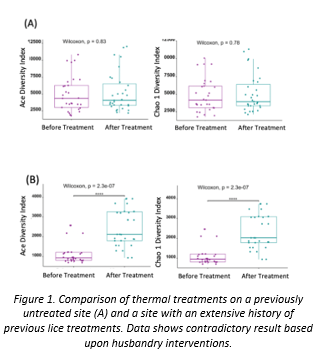IMPACT OF THERMAL DELOUSING ON ATLANTIC SALMON Salmo salar GILL HEALTH
The overall cost of salmon louse (Lepeophtheirus salmonis) infestations on the Atlantic salmon (Salmo salar) industry has been estimated to be around £700 million annually. This high cost has driven a concerted effort to develop, examine, understand, and implement a variety of methods for sea lice control. Husbandry interventions utilising high temperature or pressurised water have been highly successful in complementing traditional chemotherapeutants where efficiency has waned in recent years.
In this project, we sought to examine the impact of elevated water temperatures (thermal treatment) on gill health in two commercial sites with divergent historical husbandry and treatment interventions immediately prior to and 7 days after thermal treatment. Methods to characterise gill health and the response to thermal treatment included a detailed examination of the gill surface for microparasites using both histology and qPCR and targeted expression analysis of cellular makers of immune cells, most notably antigen presenting cells (MHC II), proinflammatory cytokines (IL-1β and TNF-α) and inhibitory cytokines (TGF-β and IL-10). Additionally, we scanned the bacterial communities present on the gill surface using a non-invasive approach. Microbiome analysis was performed through the development of a novel quantification protocol that included a titration step prior to building 16S rRNA libraries. This improved method facilitated a detailed observation of the microbial communities present in a challenging tissue.
Data obtained from these trials showed a minimal impact on gill microparasite prevalence in response to the thermal treatment. Expression of immune markers showed a significant decrease across all sites (t-test, p <0.05) after treatment. Intriguingly, marked differences on gill surface bacterial communities in response to treatment between the two sites were clearly observed. This could be due to the notable differences in the husbandry history and health status of the fish at the two sites prior the thermal treatment (Figure 1). Our data suggest that microbiome diversity is an informative indicator of fish gill health and could be used to define appropriate interventions when treating for sea lice.
